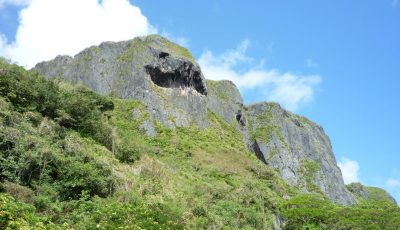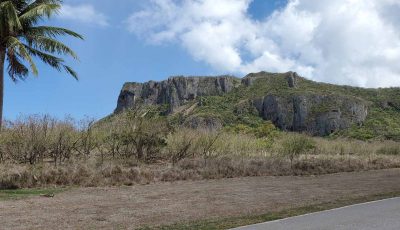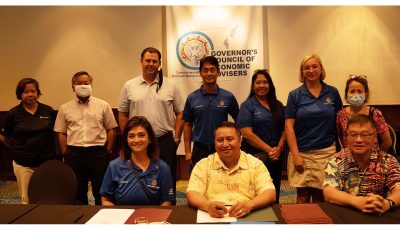New monument at Suicide Cliff

The Japanese volunteers that helped erect a new monument at Suicide Cliff are led by Kentaro Suzuki and Morito Asai (both on the right side of photo). (CONTRIBUTED PHOTO)
A group of Japanese volunteers led by Saipan businessmen Morito Asai and Kentaro Suzuki and returning tourist Kenichi Nakajima have added to the rows of memorials at Suicide Cliff with the installation last week of a new Japanese memorial that commemorates the sacrifices of all men and women who perished during the Pacific War of World War II.
As Asai tells it, the project got started after Nakajima approached him to seek help on how to erect a new memorial at Suicide Cliff.
“Mr. Nakajima is a regular tourist and loves Saipan so he knows all the Japanese landmarks on island. On one trip, he noticed that a memorial monument at Suicide Cliff was gone and he wanted to replace it to continue the tradition of respect to those who died in World War II,” Asai said. “With the help of another local organizer, building contractor Mr. Kentaro Suzuki of Moty’s Planning, we started to work on it.”
Asai said he asked Suzuki if he can shoulder the material and labor cost and he agreed. “The rest of the project was crowdfunded and we all did it as volunteers,” he said, adding that this is the same group that did the renovation work on the Last Command Post in 2018.
According to Asai, the plan to replace the monument was a team effort. “Nakajima did the work on the Japan side and talked to the Pacific War Memorial Association Inc. in Chiba, Japan and Japan Funding Public Interest Inc. Foundation. For my part, I talked to the Department of Public Lands, Marianas Visitor’s Authority, Division of Coastal Resources Management and all gave us permission,” he said.
Asai recalls that there were about 30 small statues at Suicide Cliff that were erected by families of war victims but they started disappearing one by one until around 2017, when they were all gone.
“It is still a mystery why the original monuments disappeared. Some say it was due to natural causes but some say [they were] destroyed by men. We will never know the real reason,” he said.
The important thing, Asai said, is they have replaced these small statues with one big monument “so people will have a symbol to remember war victims by.”
Asai said that the newly erected monument is made of one large boulder so it will remain strong and intact during storms and can withstand any attempt to vandalize it. “We started mid-May and finished the project last June 16. The words written in Japanese on the monument is translated in English as, ‘Not forgotten tough times, peace for the world.’”
“We want people to understand that this monument is not only to honor Japanese people who died during the war but for all people. It is a historical touchstone that gives respect to all the victims and we should not forget what happened to those people,” he added.



























